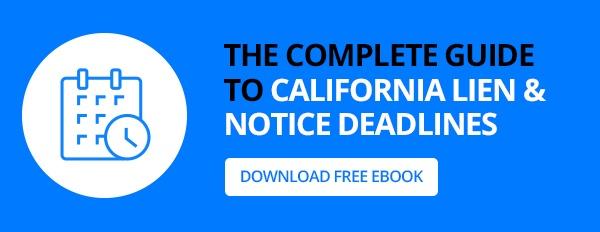Everyone who works in the construction industry in California should pay attention to the California preliminary notice requirements. The statute changed in July of 2012, so anything you read that was written before that date is likely to lead you astray.
Preliminary 20-day Notice
In California, subcontractors and suppliers must serve a preliminary notice in order to preserve their right to file a mechanics lien in the future. This “Preliminary 20-day Notice”, as it’s commonly called, must be served on the owner, general contractor and, if applicable to the project, the construction lender. The reasoning for this requirement is to inform the people who control the construction project money of everyone who is working on the project so they can better forecast their payment obligations. It is also believed that by forcing you to serve the preliminary notice, this will facilitate communication so payment problems can be prevented before a mechanics lien in necessary.
Regardless of the reasoning behind the law, you must serve the preliminary notice for two very important reasons. First, failing to serve the notice bars you from filing a mechanic’s lien for nonpayment in the future. Second, you can be fined if you don’t file the notice.
Exceptions to the California Preliminary Notice Requirements
There are a few exceptions to the California preliminary notice requirements. One is if you are the general contractor, the law assumes the owner already knows you are working on the project, so notice is necessary. The general contract must still, however, file a preliminary notice on the construction lender if there is one. Also, if you are a laborer on a project you don’t have to serve the preliminary notice because, like a general contractor, the law assumes the owner knows who their general laborers are. The last exception is if you are providing less than $400 of work or materials.
What if your notice is served later than 20 days
The law requires you to serve your preliminary notice within 20 days after you first furnish labor or materials on the project. If your notice is later than 20 days, it can still be valid but it will only protect the payments for goods or services provided 20 days before the notice is served and those goods and services provided after serving the notice. This means you want to send your preliminary notice shortly after you begin working in order to preserve your right to file a mechanics lien, if that becomes necessary.
Specific information needs to be included in your notice. California preliminary notices must contain, at a minimum, the following information and text:
- Name and address of the owner or reputed owner
- Name and address of the director contractor
- Name and address of the construction lender, if any
- Description of the site sufficient for identification, including the street address of the site, if any
- Name, address, and relationship to the parties of the person giving notice
- General statement of the work provided
- The name of the person to or for whom the work is provided
- An estimate of the total price of the work to be provided
- A legal notice statement in boldface type
A common obstacle
A common obstacle to preparing a correct preliminary notice is that you don’t have all of the required information listed above. To avoid this problem, many subcontractors and suppliers request this information from the contractor they are working for as soon they learn they will be working on the project. Your contractor may not be able to provide all of the information but will likely be able to give you other sources of information, such as their contractor.
How to deliver a preliminary notice in California
Once your California preliminary notice is ready to go, you have a few options in how to deliver it. The first and best option is to send the notice by certified mail, so you have proof of the date you sent the notice. Since the day you send the notice is how the 20 day notice deadline is calculated, you do not need to request a return receipt to prove the notice was received. You can also send by regular mail but you will need to prepare an affidavit attesting to the date the notice was delivered. The main goal of any method of delivery is to be able to prove you sent the notice. And the main goal of serving the preliminary notice is to protect your rights to be paid for your work and materials. To avoid losing that right, you should contact a mechanics lien specialist to assist with complying with all mechanics lien laws.
The attorneys at National Lien & Bond can not only help you put together an accurate California preliminary notice, they can also help you deliver it properly to all necessary parties and track your timing so that you don’t lose any rights to file a mechanics lien.

